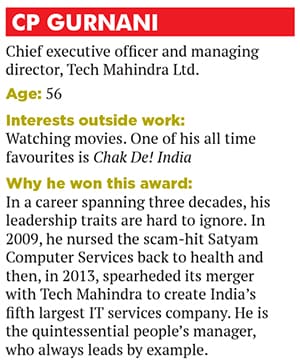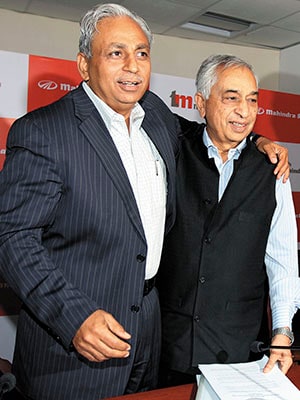
CP Gurnani: The people's CEO
Tech Mahindra's CP Gurnani is the man to get a job done. And he does it by winning the loyalty of his colleagues
Forbes India Leadership Award: Best CEO-Private Sector
The year 2009 opened with a shocker for India Inc as B Ramalinga Raju, the founder of Satyam Computer Services, confessed that he had been inflating his company’s accounts by over $1 billion. As Raju, the posterboy of India’s IT revolution, was arrested and the board disbanded by the government, it seemed Satyam had reached the end of the road. So, when Anand Mahindra acquired it in April that year, even he knew it would take much more than just a change of leadership for Satyam to regain its earlier glory. That’s when Mahindra turned to CP Gurnani, who was then heading international operations at Tech Mahindra, an IT firm owned by the Mahindra Group.

However, once he was made CEO of the newly-christened Satyam Mahindra, Gurnani took the proverbial bull by its horns, and played a pivotal role in the transformational journey of the company. Its revival was not only about winning back the confidence of clients but also the “confused and demoralised tribe of Satyamites”, as Mahindra puts it. (At its lowest point, employee attrition rates at Satyam had gone up to around 40 percent.)
According to Mahindra, Vineet Nayyar (currently vice-chairman of Tech Mahindra and former chairman of Mahindra Satyam) was convinced that Gurnani, who is known for his people skills, was the best bet to rejuvenate the Satyam staff. Back then, Nayyar had worked as Gurnani’s senior for over 10 years.
“He brilliantly used the [then] new Mahindra Group credo of ‘Rise’ to rally his troops. In fact, very quickly, it was the Satyamites who began showing the rest of the group companies how to harness the power of ‘Rise’ to deliver extraordinary performance,” says Mahindra.
How did Gurnani script such a turnaround? “There were distractions outside (such as the ongoing class action suit against Satyam), but I had to stay focussed on the job and grow the business. I put nine youngsters in [Mahindra] Satyam as my agents of change,” he says. In 2013, he spearheaded its merger with Tech Mahindra, creating a single entity that is now the fifth largest Indian IT services player by revenue. (The company ended FY2015 with $3.68 billion.)
Gurnani joined Tech Mahindra in November 2004, when the company was known as Mahindra British Telecom (MBT). Mahindra recalls that what stood out about Gurnani when he first met him more than a decade ago was his energy. “You could almost feel the electricity crackle around him. And he hit the ground running with that same energy,” he says. Using automotive terminology, he describes Gurnani as the “turbocharger of the team” with an uncanny knack of “evaluating the intrinsic ability of individuals”.
Over the years, Gurnani has built a team of loyal friends, colleagues and clients, which uses the more informal ‘CP’ while addressing him. He has a personal rapport with employees across all levels, right from the person serving him tea to the most senior executive.
Padma Parthasarathy, who has known Gurnani for nearly two decades, says late nights were the norm when she worked with him at HCL Perot Systems in 1997. But even then, Gurnani would make sure that all his team members had enough to eat while they were working late. “Anyone who didn’t have a vehicle would get a drop home. That was part of his persona,” says Parthasarathy, who is now senior vice-president and global head (consulting) at Tech Mahindra.
Eighteen years on, nothing has changed. “He still has this great ability to connect with people and is an extremely warm human being,” she says.
Gurnani’s leadership skills and ability to inspire people have won him the admiration of the IT industry. Mohandas Pai, chairman of Manipal Global Education Services and former board member of Indian IT giant Infosys, says Gurnani’s leadership is a “great case study of integrating a fallen company and restoring it to an enviable position”. In the past three years alone, Gurnani has received five awards (including the Forbes India Leadership Award 2015) that speak volumes about his achievements. But, for the CEO, who traces his roots to a middle-class family in Neemuch, a small town in Madhya Pradesh, recognition and awards are purely incidental.
Gurnani’s father worked as a senior officer in the Central Bureau of Narcotics, a job that involved multiple transfers. “My father was a straightforward, simple and honest man. The only way people would tolerate him was by transferring him out.”
As a result, Gurnani’s schooling took place across Chittorgarh, Kota, Jodhpur and Jaipur in Rajasthan. “Despite all these transfers, my kindergarten, school and college friends joined me to celebrate my daughter’s (Sanya) wedding this August. These are my proudest moments and they don’t get you an award. I can promise you that,” says Gurnani.
The almost-nomadic nature of his childhood days seems to be continuing even now: Gurnani spends just about 10 days in a month at Tech Mahindra’s offices in Noida’s Special Economic Zone, about 15 km from his home in Sector 17. The rest of the month is spent hopping across offices in India and abroad.
But such a frenetic pace of life doesn’t tire the 56-year-old because he always goes back to what his father would tell him when they moved to a new city: “You’re going to a new city, to a new neighbourhood, and to a new school. The city does not need you, the neighbourhood does not need you, and the school does not need you. But you need all of them. The initiative belongs to you and nobody owes you anything.”
Gurnani follows this worldview even now. “I believe that when I wake up in the morning, nobody owes me anything. I have to make my place in this world,” he says. The constant change of cities in his youth, he adds, has moulded him into a “great survivor”—a trait that stood him in good stead during a particularly turbulent phase at HCL Perot Systems.
Thirty-four years ago, a young Gurnani, fresh out of college with a degree in chemical engineering from National Institute of Technology, Rourkela, could not have predicted where his life would take him. In those days, information technology was not common in the Indian business lexicon. The technology sector then was all about hardware, electronics and computers, which didn’t interest Gurnani.
After graduation, he considered many entrepreneurial ideas, some of which included starting a micro-nutrient business and setting up a mini cement plant. “The only hesitation at that point was capital. I knew that my father would have bet every bit of money he had on me. But I would have gone ahead if it was my money I was betting on,” says Gurnani. He dumped his ideas and bagged a job as a graduate chemical engineer trainee at JK Synthetics (now JayKay Enterprises). It was only in 1986 that he switched to computers and joined the then HCL Ltd, which was largely into hardware development.
“At that time, computers was a sunrise industry and I took a conscious decision to work in such a sector,” says Gurnani. At HCL, he rose from the position of an area manager to the country sales manager and eventually became senior vice-president (corporate). He was also responsible for the joint ventures that HCL did with companies like Perot Systems, Deluxe Corporation and General Instruments, among others.
In 1996, technology entrepreneur Shiv Nadar’s HCL Technologies (a spin-off from HCL Ltd) floated a joint venture (JV) with the US-based Perot Systems to tap into the growing software outsourcing market. Nadar had entrusted Gurnani with the task of finalising the JV. “I was negotiating a legal contract without a lawyer sitting next to me. I called up Shiv and said, ‘I think I need to have a legal firm.’ He said, ‘What will they tell you that you don’t already know?’ ” he recalls. Nadar’s response, says Gurnani, “taught me that if you are 70 percent ready for the job and have the right attitude then you can accomplish just about anything.”
Initially, the HCL Perot JV was not making money, but with some deft negotiations, Gurnani ensured that the company was not making losses either. For instance, he was instrumental in bagging an outsourcing deal worth $50 million from UBS, a global financial services company. It was quite a feat given that, at the time, HCL Perot had a net worth of $50 million.
By the turn of the millennium, however, the two JV partners were locked in a heated boardroom battle. At the time, Gurnani was the chief operating officer of HCL Perot Systems and Vineet Nayyar the CEO. A November 20, 2002, report in The Economic Times noted that Perot Systems was seeking the removal of both.
The mudslinging between the two feuding partners, with Gurnani caught in the middle, unsettled him. Recalling that turbulent period, he says, “It was not funny being covered in newspapers with Perot Systems alleging that HCL was stealing intellectual property rights.”
Eventually, in 2003, Perot Systems bought out HCL Technologies’ stake in the JV for around Rs 480 crore. It was seen as an amicable settlement.
Looking back, Parthasarathy says, “He did go through a lot and became a victim of the case. It was a fairly traumatic time for CP. There were lots of dynamics at play, but through all that he was focussed on the business. CP realised that the company had a set of customers who could not be let down as a result of what was going on.” She remembers how Gurnani was open in his discussions with colleagues on the goings-on. “We never felt that we were out of the loop or that he was hiding things from us,” she says.
Parthasarathy feels the evolution of Gurnani as a manager happened between the time he started working at HCL Perot and when he moved out. Gurnani agrees: “The learnings there were some of the best in my life.” He fell back on those experiences when he was tasked with turning around Mahindra Satyam.
Eleven years ago, when Gurnani joined MBT, the company had 5,000 people and clocked revenues of about $100 million. Today, Tech Mahindra has a workforce of 1.3 lakh people and is among the top 30 listed Indian companies by way of market capitalisation.
That said, the Indian IT industry is going through a phase of transformation. The outsourcing model is changing with companies adopting and acquiring newer technologies. “It is not a time to be rigid and be wedded to past strategies,” says Mahindra. “CP has the perfect outlook in that he is setting in motion some critical experiments within the company.”
Some of these experiments include a startup incubation programme to support and encourage entrepreneurial spirit among employees. In addition, Gurnani has launched a host of special leadership programmes such as ‘Young CEOs’, ‘1000 leaders’, the ‘Global Leadership Cadre’, and ‘Achiever in the Making’, to ensure that Tech Mahindra has a pipeline of future leaders.
Dinesh Goel, partner and India head at international advisory firm ISG, believes that Tech Mahindra’s successes have a great deal to do with Gurnani’s leadership. “Steering the company on a high-growth trajectory and rallying people behind requires an energetic and charismatic leadership.”
In the last two years, Tech Mahindra has reported an average annual revenue growth of 18.3 percent, outpacing the IT industry’s rate of 12-14 percent. But Gurnani chooses to shun all limelight. “I am the leader of an orchestra. It’s the music that has to be a hit, not me as the orchestra leader,” he says.
Here’s to the master conductor holding many more symphonies.
(This story appears in the 30 November, -0001 issue of Forbes India. To visit our Archives, click here.)






